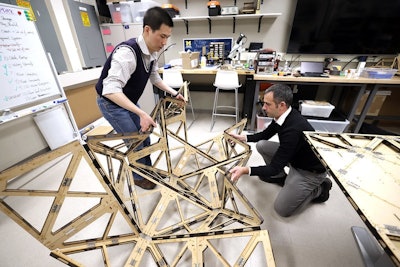
Engineers at the University of Michigan say they have found a way to make foldable “origami module” structures that could one day be used for such things as quickly setting up bridges in disaster areas.
Deploying these folding, load-bearing structures could mean faster repairs on damaged infrastructure after natural disasters or working in spaces that were previously impractical, they say. Possible uses outlined in a study ("Large-scale modular and uniformly thick origami-inspired adaptable and load-carrying structures") published March 15 in Nature Communications include bridges, walls, floors and columns.
In one example given, a package that unfolds from a 1.6-foot-wide cube can deploy into multiple configurations: a 13-foot-long walking bridge, a 6.5-foot-tall bus stop or a 13-foot-tall column.
The technology shown in the study – called the Modular and Uniformly Thick Origami-Inspired Structure System – is also ideal for temporary structures that could be set up and taken down with relative speed, such as concert stages.
 The technology is ideal for temporary structures that could be set up and taken down with relative speed.Nature Communications
The technology is ideal for temporary structures that could be set up and taken down with relative speed.Nature Communications
The system improves upon other modular building systems (see image above) by having a larger number of deployable configurations and transforming into smaller packaging for transportation, according to the study. The origami method could be used with wood, metal, plastic, or encased glass as materials. Researchers used mid-density fiber board in the lab.
The authors of the study believe the concept will challenge traditional engineering practices and offer broader applications in aerospace systems, space habitats, robotics and more.
The published study states future civil structures must:
- Be able to adapt to multiple configurations in response to changing environments and user needs (e.g. change in building floor plans).
- Be packaged in small volumes and rapidly deployed at target locations. Dense packaging would allow efficient transport of these systems for reuse at other locations.
- Be stiff and strong enough to serve as buildings and infrastructure.
Uniform Components
In creating this concept, University of Michigan researchers solved a problem that had preciously plagued the concept of foldable structures: making them load bearing without compromising the speed of assembly.
Yi Zhu, research fellow in mechanical engineering and first author of the study, is credited with discovering the breakthrough that made the foldable structures possible. Specifically, uniform thickness among components ended up making the models viable, where previous research had only bolstered specific portions of the structures.
“When people work with origami concepts, they usually start with the idea of thin, paper-folded models – assuming your materials will be paper-thin,” Zhu said. “However, in order to build common structures like bridges and bus stops using origami, we need mathematical tools that can directly consider thickness during the initial origami design.”
For a closer look at the structures and their potential uses, check out the University of Michigan video below:














